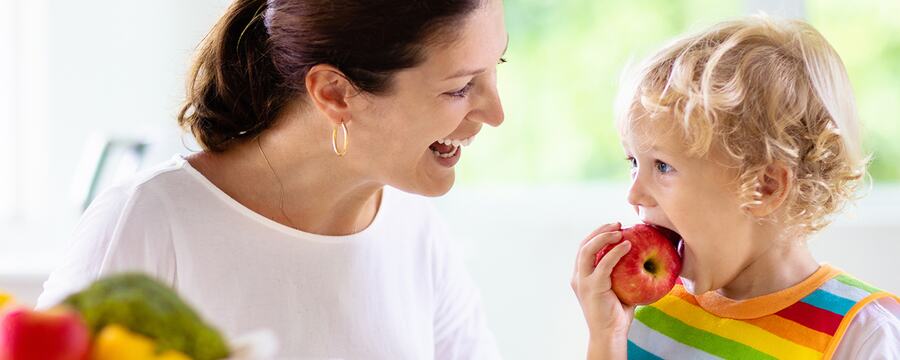Infant Nutrition: Introducing Solid Foods

Share this step
You may think something as natural as transitioning from breast or formula milk to solid foods would be quite simple, yet we know that many parents feel very anxious about this transition.
While the nutritional requirements of an infant in their first year are high and it’s important that we meet their dietary needs through the addition of nutritious foods, it’s good to understand that milk – whether breast or infant formula – remains a key source of nutrients for at least the first 12 months of life.
This means that in the first few months of eating (from around six to nine months), foods (with the exception of iron-rich foods) can be thought of as opportunities to experience tastes and textures rather than just as sources of nutrition.
Traditionally, we advise parents to offer breast or formula milk before offering solids until babies are about eight months old. At around this age, infants are getting the hang of eating and progressively managing to supplement their nutrient needs. This means that from around eight months, food can be offered before milk.
As we’ve now discussed, there is no universally accepted best way to feed infants over six months of age. The ways we feed our babies is strongly informed by our social and cultural norms and practices. We need to consider alongside the scientific evidence about infant feeding.
Nutritional priorities in summary
 © Getty Images |
Infant’s iron requirements Examples (from 8 months of age):
|
 © Getty Images |
Providing nutrient-dense foods Make sure foods are big on nutrients. |
 © Getty Images |
Order of food introduction No particular order in Australia. Best to have iron rich or iron-enriched foods included alongside other food offerings. |
 © Getty Images |
Preventing allergies Refer to the Australian Society of Clinical Immunology and Allergy infant guidelines, or similar guidelines in your country. |
 © Getty Images |
Providing a wide range of foods Provide a wide variety of tastes, textures, colours and flavours but avoid foods containing added sugars. |
 © Getty Images |
Managing food preferences Offer fewer sweet vegetables first: for example, broccoli, courgette (zucchini), aubergine (eggplant) and beans before carrots, peas, pumpkin. |
 © Getty Images |
Providing single vs blended foods Best to offer single items where possible. Be aware of commercial mixed baby foods. |
Nutritional priorities in detail
The following information provides some further important guidelines and advice to consider when introducing solid foods to infants.
Meeting an infant’s iron requirements
In Australia, it’s recommended that first foods be iron-containing foods, including iron-enriched infant cereals, pureed red meat, poultry and fish, or cooked tofu and legumes.
Providing nutrient-dense foods
An important priority is to ensure all foods offered to infants have a high nutrient density. In other words, it’s important to maximise the nutritional quality, rather than quantity, of each serve offered.
Order of food introduction
Other than the recommendation to include iron-rich foods among an infant’s first foods, there are no Australian recommendations stipulating the order in which other foods should be introduced or the number of foods that should be introduced at once.
Preventing allergies
The advice for preventing the risk of food allergies has changed over time, as has the emphasis on ensuring that all children are exposed to egg and dairy, fish and nuts (not whole nuts, but ground nuts or nut paste) to reduce the risk of allergies and/or allergic reactions.
Advice provided in the Australian Society of Clinical Immunology and Allergy infant guidelines is that current best-practice evidence suggests that early exposure in life (at around six months and preferably while breastfeeding) to all foods will protect against the development of food allergy.
Advice about allergy prevention and timing of the introduction of solids may vary from country to country.
Providing a wide range of foods
New parents should aim to expose children to a variety of tastes, textures, colours and flavours to maximise their enjoyment of a wide range of nutritious foods. This encouragement should stop short of juices and sugar-sweetened drinks or high sugar or high-fat foods, which are not ideal for children.
Managing food preferences
New research about a baby’s food preference development suggests that infants learn to enjoy non-sweet tasting vegetables as children (and then as adults) if they are offered these as their very first foods.
So, before we offer sweeter tasting vegetables like sweet potato, carrots and peas, or fruits – all of which children will usually enjoy – it may make good sense to offer a wide range of less sweet vegetables in these early weeks of food introduction.
These could include courgette (zucchini), aubergine (eggplant), beans, spinach or other greens, broccoli and mushrooms – indeed any less sweet vegetable you can think of – cooked then puréed or mashed.
Providing single versus blended foods
While it’s not necessary for any nutritional purpose to provide foods to infants as single items, our research suggests that it may assist them to better experience a broad range of tastes and, in turn, learn to like these tastes if we offer foods separately.
On this topic, it’s interesting to note that commercial baby foods frequently mix a sweet vegetable or fruit with other vegetables (eg beef, tomato and sweet potato; or pumpkin, corn, broccoli and quinoa) to maximise the chance of children enjoying their offerings (and increasing the likelihood of parents purchasing these products again).
The problem with mixing foods is that the non-sweet vegetable is unlikely to be enjoyed on its own when offered in the future, thus setting up a cycle of limited food enjoyment.
Limited enjoyment of sole foods becomes particularly problematic when we consider a child’s future vegetable intakes. Children – and the adults they grow up to be – tend to consume far fewer vegetables than they need for good health. This becomes a problem given the central role vegetables have in promoting and protecting our lifelong health.
For these reasons alone, it makes great sense to set up a wide range of food preferences in our children from the start of life.
Share this
Infant Nutrition: from Breastfeeding to Baby's First Solids

Infant Nutrition: from Breastfeeding to Baby's First Solids


Reach your personal and professional goals
Unlock access to hundreds of expert online courses and degrees from top universities and educators to gain accredited qualifications and professional CV-building certificates.
Join over 18 million learners to launch, switch or build upon your career, all at your own pace, across a wide range of topic areas.
Register to receive updates
-
Create an account to receive our newsletter, course recommendations and promotions.
Register for free







